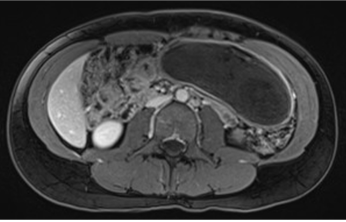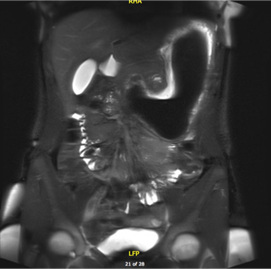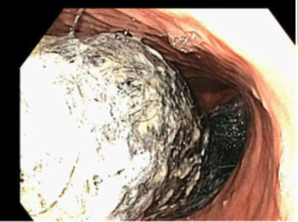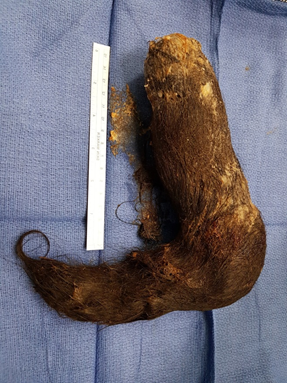A Case of Large Gastric Trichobezoar: Case Report and Review of Literature
Article Information
Anthony Lamanna*#, Ankur Sidhu*#, Jonathan Foo, Ahmad Aly
Upper Gastrointestinal Surgery Unit, Department of Surgery, Austin Health, Melbourne, Victoria 3084, Australia
*Corresponding Author: Dr. Ankur Sidhu, Upper Gastrointestinal Surgery Unit, Department of Surgery, Austin Health, Melbourne, Victoria 3084, Australia, Tel: +61384058000;
#Both the authors contributed equally
Received: 24 May 2018; Accepted: 06 June 2018; Published: 12 June 2018
Citation: Anthony Lamanna, Ankur Sidhu, Jonathan Foo, Ahmad Aly. A Case of Large Gastric Trichobezoar: Case Report and Review of Literature. Archives of Clinical and Medical Case Reports 2 (2018): 101-105.
Share at FacebookAbstract
Trichobezoars are concretions of swallowed hair retained within the digestive tract, most commonly the stomach. They predominate in young females during childhood and adolescence and are usually associated with psychiatric illness. These usually develop insidiously and hence at presentation are large in size. In this report, we present a case of a young female patient with large 17.5 × 12.2 × 5 cm trichobezoar that had to be surgically removed.
Keywords
Bezoar; Trichobezoar; Rapunzel syndrome
Bezoar articles Bezoar Research articles Bezoar review articles Bezoar PubMed articles Bezoar PubMed Central articles Bezoar 2023 articles Bezoar 2024 articles Bezoar Scopus articles Bezoar impact factor journals Bezoar Scopus journals Bezoar PubMed journals Bezoar medical journals Bezoar free journals Bezoar best journals Bezoar top journals Bezoar free medical journals Bezoar famous journals Bezoar Google Scholar indexed journals Trichobezoar articles Trichobezoar Research articles Trichobezoar review articles Trichobezoar PubMed articles Trichobezoar PubMed Central articles Trichobezoar 2023 articles Trichobezoar 2024 articles Trichobezoar Scopus articles Trichobezoar impact factor journals Trichobezoar Scopus journals Trichobezoar PubMed journals Trichobezoar medical journals Trichobezoar free journals Trichobezoar best journals Trichobezoar top journals Trichobezoar free medical journals Trichobezoar famous journals Trichobezoar Google Scholar indexed journals Rapunzel syndrome articles Rapunzel syndrome Research articles Rapunzel syndrome review articles Rapunzel syndrome PubMed articles Rapunzel syndrome PubMed Central articles Rapunzel syndrome 2023 articles Rapunzel syndrome 2024 articles Rapunzel syndrome Scopus articles Rapunzel syndrome impact factor journals Rapunzel syndrome Scopus journals Rapunzel syndrome PubMed journals Rapunzel syndrome medical journals Rapunzel syndrome free journals Rapunzel syndrome best journals Rapunzel syndrome top journals Rapunzel syndrome free medical journals Rapunzel syndrome famous journals Rapunzel syndrome Google Scholar indexed journals psychiatric illness articles psychiatric illness Research articles psychiatric illness review articles psychiatric illness PubMed articles psychiatric illness PubMed Central articles psychiatric illness 2023 articles psychiatric illness 2024 articles psychiatric illness Scopus articles psychiatric illness impact factor journals psychiatric illness Scopus journals psychiatric illness PubMed journals psychiatric illness medical journals psychiatric illness free journals psychiatric illness best journals psychiatric illness top journals psychiatric illness free medical journals psychiatric illness famous journals psychiatric illness Google Scholar indexed journals Case Report articles Case Report Research articles Case Report review articles Case Report PubMed articles Case Report PubMed Central articles Case Report 2023 articles Case Report 2024 articles Case Report Scopus articles Case Report impact factor journals Case Report Scopus journals Case Report PubMed journals Case Report medical journals Case Report free journals Case Report best journals Case Report top journals Case Report free medical journals Case Report famous journals Case Report Google Scholar indexed journals treatment articles treatment Research articles treatment review articles treatment PubMed articles treatment PubMed Central articles treatment 2023 articles treatment 2024 articles treatment Scopus articles treatment impact factor journals treatment Scopus journals treatment PubMed journals treatment medical journals treatment free journals treatment best journals treatment top journals treatment free medical journals treatment famous journals treatment Google Scholar indexed journals patients articles patients Research articles patients review articles patients PubMed articles patients PubMed Central articles patients 2023 articles patients 2024 articles patients Scopus articles patients impact factor journals patients Scopus journals patients PubMed journals patients medical journals patients free journals patients best journals patients top journals patients free medical journals patients famous journals patients Google Scholar indexed journals stomach articles stomach Research articles stomach review articles stomach PubMed articles stomach PubMed Central articles stomach 2023 articles stomach 2024 articles stomach Scopus articles stomach impact factor journals stomach Scopus journals stomach PubMed journals stomach medical journals stomach free journals stomach best journals stomach top journals stomach free medical journals stomach famous journals stomach Google Scholar indexed journals kidney articles kidney Research articles kidney review articles kidney PubMed articles kidney PubMed Central articles kidney 2023 articles kidney 2024 articles kidney Scopus articles kidney impact factor journals kidney Scopus journals kidney PubMed journals kidney medical journals kidney free journals kidney best journals kidney top journals kidney free medical journals kidney famous journals kidney Google Scholar indexed journals diagnosis articles diagnosis Research articles diagnosis review articles diagnosis PubMed articles diagnosis PubMed Central articles diagnosis 2023 articles diagnosis 2024 articles diagnosis Scopus articles diagnosis impact factor journals diagnosis Scopus journals diagnosis PubMed journals diagnosis medical journals diagnosis free journals diagnosis best journals diagnosis top journals diagnosis free medical journals diagnosis famous journals diagnosis Google Scholar indexed journals
Article Details
Untitled Document
1. Introduction
Trichobezoars are concretions of swallowed hair retained within the digestive tract. Psychiatric illness and mental retardation are commonly associated with trichobezoars [1]. The consumed hair is retained between the gastric folds and resists peristaltic movement due to its slippery surface [2]. The hair is then denatured by gastric acid, becomes black due to oxidation and compacted with food to form an enmeshed mass [3]. The insidious development of trichobezoar accounts for the delayed presentation and large size at the time of diagnosis [4]. Some types of bezoars, including small trichobezoars, can be removed endoscopically. Larger trichobezoars are typically resistant to endoscopic fragmentation due to the dense hair mass and require surgical removal. Here we present case of a young patient with large trichobezoar that had to be surgically removed.
2. Case Study
A 20-year-old female was referred to the surgical clinic with newly diagnosed epigastric mass. She was high functioning, took no regular medications and had no prior medical history. Upon further questioning, the patient reported trichophagia up until the age of 13 years. She denied any abdominal pain, nausea or vomiting. Her bowels had been functioning well. She reported weight loss of approximately 20 kg over a 12-month period which she attributed to diet and exercise. On examination, the patient was of thin built, with no visible alopecia. A large, firm epigastric mass was palpated which was mobile and non-pulsatile. The patient’s blood tests were all within normal range. She underwent an ultrasound which showed a large, partially calcified mass measuring 11 ? 9 ? 7 cm within the stomach which not visible on x-ray. A follow up MRI scan (Figure 1a and 1b), given patient’s age, showed a well-defined, smooth-contoured mass within the lumen of the stomach with low signal on T1, low signal on T2 and internal heterogeneity. Its dimensions were 17.5 ? 5.1 ? 12.2 cm and were entirely surrounded by fluid.

Figure 1a: MRI abdomen in axial view showing a large mass within the stomach.

Figure 1b: MRI abdomen in coronal view showing a large mass within the stomach with fluid in stomach outlining the shape of the mass.
Subsequently, the patient underwent gastroscopy to investigate this mass further. This revealed a large trichobezoar extending from the stomach into the duodenal bulb (Figure 2). Given the size, it was decided that patient should undergo an open operation to remove the trichobezoar. Patient underwent mini laparotomy and open gastrostomy to remove the large trichobezoar (Figure 3). The patient recovered well post-operatively and was discharged home 5 days later.

Figure 2: Endoscopic view showing a large trichobezoar within the stomach.

Figure 3: Image of operative specimen showing the large trichobezoar.
3. Discussion
A bezoar is an indigestible mass of foreign material found within the digestive tract, most commonly in the stomach. Bezoars are named based on their components [5]. Phytobezoars ? the most common type of bezoar ? are comprised of vegetable matter high in cellulose, hemicelluloses and other proteins. Trichobezoars (hair), pharmacobezoars (medications) and lactobezoars (milk products) are more uncommon types of bezoars. The first trichobezoar was described by Baudamant. Rapunzel syndrome, first described by Vaughn et al., is used to describe a trichobezoar which extends into the small intestine due to its long tail [6].
Trichobezoars predominate in young female during childhood and adolescence and are strongly associated with psychiatric illnesses, in particular trichotillomania and trichophagia [7]. Consumed hair remains in the digestive tract as its slippery surface allows it to escape peristaltic movement [8]. Gastrointestinal mucous makes the trichobezoar shiny while hair turns black as it is oxidised and denatured. As hair consumption continues, peristalsis enmeshes the hair with food with the foreign body gradually taking the shape of the lumen [1, 9]. By occupying space within gastric lumen, food consumption is restricted and patients often experience weight loss. Trichobezoars may also case halitosis as they become colonised with bacteria [3, 9].
Abdominal imaging is useful for determining if multiple bezoars are present. Computed tomography is often the imaging modality of choice and typically shows a well-defined heterogeneous mass interspersed with air within the lumen, with bowel distension if there is an element of obstruction [9]. There are few cases in the literature describing the MRI findings of trichobezoars [10].
Treatment of bezoars differs depending on their composition. Chemical dissolution works well for phytobezoars and is first line treatment; however it is not useful in managing trichobezoars [7, 8]. For phytobezoars resistant to chemical dissolution and trichobezoars, endoscopic fragmentation using a variety of instruments or lithotripsy can be used [5]. For bezoars that are resistant to endoscopic management or for patients that present with complications, surgical removal is indicated. Laparotomy and gastrotomy has produced the best results; however less invasive laparoscopic techniques have also been published [1, 3, 8].
Our patient underwent laparotomy and gastrotomy to remove the trichobezoar due to its size. She was followed up in the clinic four weeks post-operatively and was recovering very well.
References
- Caiazzo P, Di Lascio P, Crocoli A, et al. The Rapunzel syndrome. Report of a case. Il Giornale di Chirurgia 37 (2016): 90-94.
- Soon CK, Seong HK, Sun JK. Large trichobezoar causing Rapunzel syndrome. Medicine: Clinical case report 95 (2016): 1-4.
- Couceiro A, Viveiro C, Capelao G, et al. Trichobezoar ? A rare cause of abdominal mass and gastric outlel obstruction. GE Portuguese Journal of Gastroenterology 23 (2016): 50-53.
- Zamir D, Goldblum C, Linova L. Phytobezoars and trichobezoars: A 10-year experience. J Clinical Gastroenterology 38 (2004): 873-876.
- Ugenti I, Travaglio E, Lagouvardou E, et al. Successful endoscopic treatment of gastric phytobezoar: A case report. Int J Surg Case Rep 37 (2017): 45-47.
- Vaughan ED Jr, Sawyers JL, Scott HW Jr. The Rapunzel syndrome. An unusual complication of intestinal bezoar. Surgery 63 (1968): 339-343.
- Yik YI, How AK. A 'Hairy' problem: Trichotillomania, trichophagia and trichobezoars. Singapore Med J 57 (2016): 411.
- Dixit A, Raza MA, Tiwari R. Gastric Trichobezoar with Rapunzel Syndrome: A Case Report. J Clin Diagn Res 10 (2016): PD10- PD11.
- Barrows A, Vachon T, Campin RC, et al. Trichobezoars Detected and Treated Based on Plain Radiography. Military Medicine 180 (2015): e1136.
- Sinzig M, Umschaden HW, Haselbach H, et al. Gastric trichobezoar with gastric ulcer: MR findings. Pediatr Radiol 28 (1998): 296.
Citation: Anthony Lamanna, Ankur Sidhu, Jonathan Foo, Ahmad Aly. A Case of Large Gastric Trichobezoar: Case Report and Review of Literature. Archives of Clinical and Medical Case Reports 2 (2018): 101-105.
